

"Sometimes the local deity was simply called a saint, e.g., Thor's holy
well at Thorsås in Sweden was known as Saint Thor's Spring."
-A HISTORY OF PAGAN EUROPE by Prudence Jones and Nigel Pennick
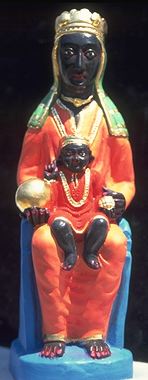
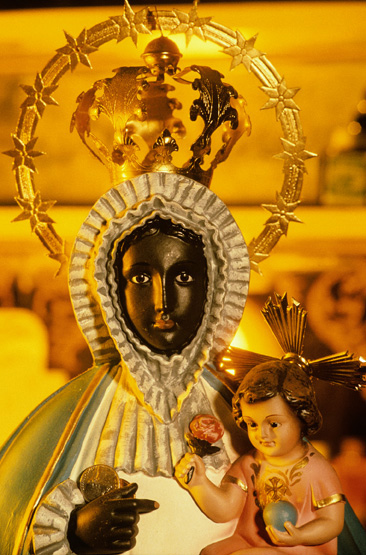
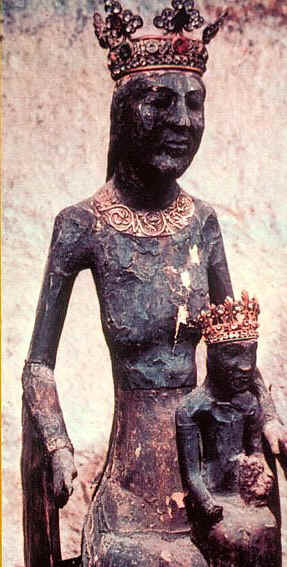
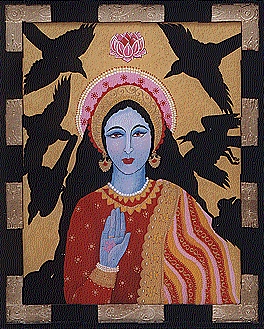
Our Lady of Mysteries
-by Christiana Miller
Iconfusion
(off site link)
One wyrd component of my interest in Woden seems to be the enchantment of the Black Madonna. I sometimes feel the guidance of the Dark Virgin as I follow the meandering path of the Raven Lord. Does my Lady Urd/Hela wear the cloak of Mary? I know not. But methinks All-Father's trail may lead back to Her.
"You could not do better than to go where it is dark, that is,
unconsciousness."
- Meister Eckhart, 14th century
"The Black Madonna is known to some worshippers as 'Our Lady of the Underworld',
which bears a striking resemblance to pagan imagery of a supreme female deity. In
the North, this dynamic is found in the very early images of the Mother Goddess: Nerthus
as 'light' and Holda as 'dark', and later images of Frigga and Freyja (light) and Hella
(dark). Hella rules the underworld realm of Hel found on Yggdrasil, the Northern
World Tree. It appears the Black Madonna has some evolutionary correspondence to
these earlier female deities."
- The Denali Institute of Northern Traditions, True North Vol.6, No.2
Feb. 1996
"There is a vast amount of her folklore still surviving and there are probably
millions in those regions who still follow Hulda, though under a different name.
Over the past thousand years a thin veneer of Christianity has been applied and the
Goddess has been re-named as 'Mary,' with her deeds and sayings transferred mostly intact
as part of the local versions of Judeo-Christianity."
- Ed Fitch, The Rites of Odin 1990
"If the cult of the Black Virgin attracts to itself elements from other,
submerged, cults, it would be surprising if Wotan, the master of disguise and
infiltration, were not represented in it."
- Ean Begg, The Cult of the Black Virgin 1985
"It is this repressed aspect of Wotan that especially relates him to much in the
cult of the Black Virgin. His beloved Brunnhilde, whose disobedience ushered in the
new age of humanity, had a daughter, the last of the Volsungs, Aslog. She lived on
in Norway as a sooty-faced kitchen-maid whose name means 'raven'."
- Ean Begg, The Cult of the Black Virgin 1985
"Kara the Walkrie-wife of Helgi, Prince of the Haddingas, is the Wodenic equivalent of the Dark Goddess- Kali- of the Hindus." - Wodens Folk
"The earth goddess, Kali (Hindu goddess of destruction and renewal) is considered one of the prime archetypes of the Dark Madonna. That Kali—wielding a bloody sword, belt adorned with the arms of men she has killed, and a necklace of skulls—is being associated with the Madonna is quite a concept to contemplate. When I discovered that Sara-la Kali, worshipped by the Gypsies, was associated with Kali, the mother goddess of their homeland, India, I knew I had found the right Madonna to explore in my work."JBL image of the Black Madonna of Monserrat
The first time that I ever consciously prayed to Thor was during a thunder storm when I was an adolescent. I had recently read a library book on Norse Mythology and was captivated by the colorful world of gods and giants. Being a naive altar boy at the time, I was completely committed to my Roman Catholic faith. What made me secure about addressing Thor was the fact that the book had spoken of a God higher (but not in conflict) with the gods of Asgard. This mysterious Original God had no quarrel with Germanic gods such as Odin and Thor. At that point in my life I knew little of religions other than the one I practiced, so I simply equated this Creator with Yahweh. I remember being very pleased speaking to Thor during that storm. Since this acknowledgment did not interfere with my Catholicism, I felt perfectly comfortable conversing with the Thunderer.
What I didn't know then was that the Higher God mentioned in the book was not always essentially identical to the Old Testament god. It would be many years before I discovered the existence of Gnostic Christianity, which often claimed that the God of Jesus was not necessarily the god of Abraham.*
* My comments about the god Yahweh/Jehovah/Allah are not meant to disrespect the many
Judaeo-Christian-Islamic traditions that consider this deity to be the Supreme Being. I usually take great care to distinguish between God (with a capital G) and
gods (with a lower case g). Although Yahweh is definitely a tribal god under
the Supreme Being, it is not entirely inappropriate for Semitic folks to view him as God.
In northern Europe Odin/Woden was also sometimes known as God by
the Teutonic people. As the heads of their respective pantheons, Yahweh and Odin
both take on the role of God serving as representatives or symbols of the Nameless
One. However neither should be confused with the Original Cause.
My early attempts to connect with ancestral gods would
remain in the back of my mind for a great deal of time. I was almost a decade and a
half away from discovering a living religion called Asatru.
A place for Christo-Heathenry...
Most Asatru publications will not hesitate to mention the various conflicts that often occur between Heathenry and Christianity. In fact, Asatruar usually derive a great deal of satisfaction in pointing them out. As this tension is undeniably a part of historical and current relations between the two religions, it is certainly important to note it.
However this web page will be taking a different approach. Like most traditional peoples, the folk of northern Europe have always been skilled at syncretistic spirituality. Over the centuries they have displayed a remarkable knack for making potentially hostile systems work well together. This is a trait that I hope I've inherited.
One of my tasks is to find some sort of common ground between the native faith of my distant ancestors and the religion of my recent grandfathers. Perhaps the key to doing this is in recognizing the many Heathen gods and traditions disguised in Roman Catholic and Eastern Orthodox garb.
Asatru has helped fill a void in my life that I never fully knew was there. It made me aware of my proud Germanic heritage. It gave me culture. This link with the Heathen past is something that modern European Americans sorely need.
Yet what has become apparent to me is that our folk will never return to their traditional ways unless some kind of meaningful continuity can be made with generations of Christian Ancestors. We can't just put aside 800 years of spiritual life in an attempt to reassemble something which is missing important pieces without first examining the cult of Saints for hidden Heathen lore. How can we truly follow an Ancestral path while we insult or ignore the religious devotion of our grandparents? As Heathens, it is our responsibility to honor all our forebears, not just the ones that lived during the Viking Age.
The vast tapestry of Ancestral faith has many different strands woven into it. Carelessly pulling out all threads of Christian influence would endanger the exquisite pattern that Wyrd has worked for us.
Most of us who are now Asatruar were not always so. Some of us even had fulfilling, if incomplete, spiritual lives prior to our involvement with Germanic Paganism. Are we then to conclude that any insights of a Christian nature that were gained during this period were irrelevant to our growth? Need we reject Christian Wisdom to sincerely espouse Heathenry? I say nay. Just as Odin's nine nights on the Tree pointed to the Cross of Christ, so can the crucifix point back to Yggdrasil.
Dare I actually suggest that one could be both Heathen and Christian?
Aye, our forefathers did as much. (Although Heathens certainly do not need to practice a Christian religiosity in order to mine it for hidden Heathen custom.)
Right now this experimental page is simply a collection of quotes that might be of
interest to a person practicing a Gnostic Christian Germanic Heathen faith. The
quotes are offered to support several ideas which could be relevant to a path which blends
Teutonic Paganism with the Gnosis of esoteric Christianity. Although some
might find this combination unusual, the goal of this site is to eventually explore both
the Nordic "santeria" practiced by our Ancestors and the compatibility of the
Northern Tradition with certain forms of Gnosticism. The aforementioned ideas are as
follows....
- There is a Unknown God higher than the tribal gods of indigenous religions.*
Orthodox Judaism and Pauline Christianity equate this Being with the Old
Testament god Yahweh. However most Gnostic sects do not. The Gnostics saw the
jealous Abrahamic god as a lesser deity who only imagined that he was the Absolute God. This lesser deity was known by such names as the demimurge and Yaldabaoth.
*
- Containing a male/female polarity of the Logos and Sophia, the Cosmic Christ is a force
much older and larger than the Galilean man named Jesus.* At various points in
history Seth, Enoch and Melchizedek were also considered incarnations of the World Teacher. Among the Germanic tribes the Spirit of the Cosmic Christ or Archangelic
Logos has often manifested in the figures of Balder and Ing-Frey. The Celts
identified this Spirit with the god Mabon. A few of the quotes I've
provided connect the Christos to various Teutonic deities other than the ones I've named
above. While to some degree the Logos can be found in all gods, in the Northern
World this was best expressed in Balder and the Vanic god Ing-Frey. Being somewhat
polytheistic, I'm not claiming that these two deities are identical to the Christ or each
other, only that they all have a similar mission and share some of the same divine energy.
Our modern concept of Jesus was invented by the Nicaen Council in the year 325 C.E. as part of Constantine's attempt to unify the Roman empire under one state religion. Prior to this the first Christians, who were Gnostic, emphasized the importance of seeing Christ as an internal Spirit rather than a historical man. The Mystery Schools of Gnostic Christianity resisted the materializing tendency of the political exoteric church. Understanding that the gospel story was completely allegorical, they did not view it as history. The Gnostics also objected to the Judaization of their mythos which had Egyptian origins.
It is possible that the character and exploits of the traditional Jesus were modeled on the lives of two separate historical men, Jehoshua Ben Pandira who lived around 100 BCE, and Apollonius of Tyana who was born in 2 CE or 4 BCE. The stories of these two individuals were meshed together with the tales of various deities creating the composite figure that appears in the gospels.
Jehoshua Ben Pandira may very well have been the mysterious Teacher of Righteousness
venerated by the Essene community. There is also the chance that he lived much
earlier than the date ascribed to him above. Some have identified Jesus Pandira as
the Old Testament Joshua, successor of Moses.
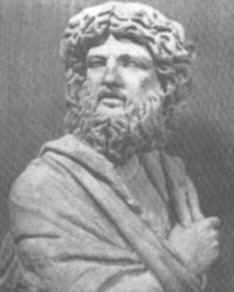
Whatever the case, the Essene followers of Jehoshua Ben Pandira expected their Messiah to
return. This would, in a way, occur in the person of Apollonius of Tyana.
Moreover, the deeds and sayings of Apollonius, who after traveling
in India reintroduced the story of Chrishna to the West, might well have become the basis
for the works and words of Paul the Apostle of Christ.
There is an obscure tradition held within metaphysical Christian thought that considers
Apollonius to be the reincarnation of the earlier Jesus. The truth or untruth of
this reincarnation scenario is insignificant compared to the possibility of the Cosmic
Christ incarnating in both of these men.
I have found the following meditation useful. When the Bishop or Priest elevates
the Host, my eucharistic contemplations will often imagine that the Host has two
images inscribed on it. On one side of the Host I visualize an image of
Ing-Frey, the Ingwaz rune or even a boar. The other side has an image
representing Balder with perhaps a Sowulo rune. This to me, best embodies the
Teutonic Christ.
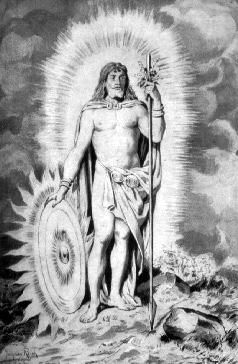
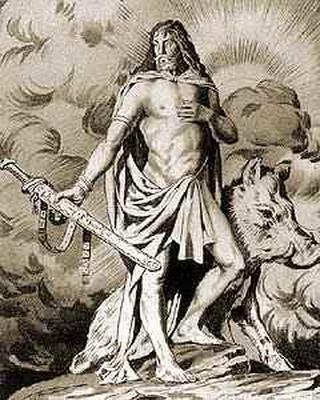
My joining of these diverse strands of thought is hardly anything new. Apart from the fact that our Ancestors were doing it for centuries, many leading figures in the early Germanic revival (such as Carl Jung) also had a dual interest in Teutonic Paganism and Gnostic Christianity.
The form of Christianity that perhaps best suited the spiritual climate of northern Europe was once known as the Arian heresy. Like Gnosticism, this Gothic church had a sensible Christology that was harmonious with the Troth of Teutonic tribes.
Perhaps one of the greatest failings of Asatru today is the implication that a person must abandon all Christian beliefs in order to truly be Heathen. As illustrated by the thriving example of Santeria, successful indigenous religions will seldom make such demands. This kind of expectation only serves to sever the close ties that bind Heathens to Christian Ancestors and family members.
The experience of Heathenry need not be at odds with a metaphysical Christian faith. This is not unlike the situation in Japan where the folk religion Shinto is overlaid with the more universal Buddhism. This actually works because the two religious systems, often observed independently of each other, are recognized as dealing with completely separate spiritual issues.
Another example of this can be found in the Native American Indian spiritual leader, Black Elk. Black Elk spent his entire life practicing the Oglala Sioux religion and working for the interests of his Lakota people. Yet what is often overlooked is the fact that he was also a devout Roman Catholic. His participation in both of these worlds was not evidence of an eclectic religiosity. It was merely acknowledging two different sides of what had become the same spiritual coin. One side of this coin could be considered tribal, the other universal.
The tribal and universal partnership is analogous to the relationship shared between the Native and Hermetic Traditions described in The Western Way by Caitlin and John Matthews.
One group that seems to have achieved a working balance between the Native and Hermetic is The Temple of Set. Despite the Egyptian imagery, The TOS is an Universal system with a healthy appreciation for the various Native/Tribal streams underlying it. Specifically, this modern school of the Left Hand Path seems to enjoy an intellectual association with the Rune Gild, a distinctly Germanic expression of tribal Wisdom. The Temple of Set has, in fact, much in common with Gnosticism. Beyond a mutual emphasis on transcendence and Gnosis, they share a common patron. The Biblical Seth, who was venerated by the Sethian school of Gnosticism, has his origins in the Egyptian figure of Set. As was mentioned above, Seth was often considered (in Gnostic circles) to be an incarnation of the Christ.
It might be beneficial to observe that the forms of Christianity that I advocate here are considered entirely heretical by the mainstream majority of Christendom. Your average Christian knows next to nothing about Gnosticism, Arianism, Black Madonnas or the Cosmic Christ. To the fundamentalist such mystical matters are just as taboo as the noble wisdom of Germanic/Celtic Heathenry. These compelling hidden corners of Christian thought have long been persecuted by the destructive types of Christianity which foster ignorance in the stead of Gnosis. Nevertheless even repressed variations of Christian mysticism can give Asatruar a spiritual link with past and present family members. In the corridors of esoteric Christianity, we heathens can find tools that will help us connect with x-tian Ancestors.
More than a few disclaimers....
-This effort is not an attempt to turn Asatru into a universal religion. The Gnostic elements on this page are universal. The Heathenry is not. However, a simultaneous celebration of both paths allows for a universalist understanding while still maintaining cultural integrity.
-I am not Gnostic in the classic sense. I certainly do not embrace the extreme dualism that one usually associates with Gnosticism.
-This web site has infinite potential to annoy my fellow Asatruar. No offense is intended to Odin's Holy Nation. Rather it is hoped that this material will inspire further investigation into the traditions held by our Ancestors during the time of blended troth.
-In no way do I recognize the "sainthood" of Olaf Haraldsson. This intolerant tyrant was a murderer, not a saint. Considering the evil he wrought, it might be appropriate to view Olaf as an incarnation of a dark* Archon. Odin himself seems to have made a few efforts to shake some sense into this man but to no avail. *My use of the word 'dark' should not be confused with the positive type of darkness represented by the Black Madonna.
-Some of these quotes may appear to contradict each other. Please understand that my listing a quote does not necessarily mean that I agree with it. It is only food for thought.
-This page is but a smattering of ideas that I personally find aesthetically and spiritually pleasing. By no means do I pretend that it is anything akin to scholarship. Bear this in mind while perusing it.
-I'm not entirely sure if I have properly credited all the people I've quoted. I'll work on correcting this. At some point I'll endeavor to reorganize this information with better credits and references. If you happen to be the author of one these and you would like it removed please let me know.
The Quotes...
The Northern Tradition..."is the essential spiritual
observance of the Celtic, Anglo-Saxon, Frisian, Germanic, Norse and Baltic regions,
originating in prehistoric times and continuing in a modified and updated form until the
present day as folk-custom, the veneration of saints*, household magic
and rural practices."
- Nigel Pennick, Practical Magic in the Northern Tradition 1989
*emphasis mine
"It is this repressed aspect of Wotan that especially
relates him to much in the cult of the Black Virgin. His beloved Brunnhilde, whose
disobedience ushered in the new age of humanity, had a daughter, the last of the Volsungs,
Aslog. She lived on in Norway as a sooty-faced kitchen-maid whose name means
'raven'."
- Ean Begg, The Cult of the Black Virgin 1985
"There lives in the Teutonic peoples all that is associated with the Archangelic
powers of Odin stirring in the primitive depths of the human soul."
- Rudolf Steiner, The Mission of Folk-Souls 14th June, 1910
"From the esoteric Christian perspective of anthroposophy, Steiner described Odin
as an archangel, who had declined to advance to a higher level of evolution in order to
work with human beings."
- Ralph Metzner, The Well of Remembrance 1994
"Each of the well-established nations of the world is presided over by an Angel
Ruler who assists the race in the fulfillment of its destiny. Pallas Athene was the
Goddess Queen of the Grecian race and still serves as Angelic Ruler of one of the nations
of the world. These great Archangels- probably Thrones in Christian angelology-
inspire the nation and its leaders through the national ego or over-soul."
-Rev. Geoffrey Hodson, Clairvoyant Investigations of Christian Origins and
Ceremonial
"...Jesus here takes on the familiar attributes of Wotan. Christ the
chieftain is a magician, like Wotan, and knows the secrets of the runes. Also like
Wotan, who had the ravens Nunin and Hugin (memory and mind) perched on his shoulders,
Christ the chieftain often has a dove- a symbol of the Holy Spirit- on his."
- Richard Noll, The Aryan Christ 1997
"A bishop in the Anatolian city of Myra during the late Roman period, the
historical St. Nicholas has, throughout northern and eastern Europe, vanished in a sea of
Pagan attributes modeled on the Underworld Lord."
- Kenneth Johnson, Slavic Sorcery 1998
"Quite often the old divinities were understood to be in the guise of more than
one saint. For example Woden was expressed in different aspects through St. Michael,
St. Oswald, St. Nicholas, St. Mauritius, and even in Jesus Christ (as the 'hanged' God).
Also, single Christian figures might be split up into several pagan deities.
For example, Christ is Freyr (as 'Prince of Peace' and Lord). Baldr (as
the martyred one to return at the end of times), and Woden (as the crucified cosmic
God)."
- Edred Thorsson, Witchdom of the True 1999
"There are examples in literature of this blending of traditions, like that of
Helgi the Lean, from Landnamabok, who had been raised a Christian, but who 'called upon
Thor for seafaring and difficult decisions, and matters he considered of greatest
importance'. Also from Landnamabok is the case of Einar Thorgeirsson, who with a group of
other settlers, claimed land in north-eastern Iceland by setting up at three points an axe
(counterpart of the hammer) for Thor, an eagle for Odinn, and a cross for Christ."
- Daniel Bray, Hammer in the North: Mjollnir in Medieval Scandinavia Sydney
Gild-Hall
"The Gnostic followers of St. Nicholas, the Nicolaites, taught that the only way
to salvation lay through frequent sexual intercourse. In northern Europe, St.
Nicholas absorbed Pagan attributes from Woden (Odin), chief of the wild hunt, who rides
through the sky with reindeer and forty-two supernatural huntsmen. Since the
Reformation, this saint has become merged with the Father Christmas of Yuletide."
- Nigel Pennick, The Pagan Book of Days 1992
"The national religion of Japan, Shinto, has sometimes been called the 'sister
religion' of the Troth. This is quite apt, as both are ancestral religions. In the
typical Japanese household there may be one or two shrines. One usually Shinto in
nature, the other Buddhist. The Japanese have no problem in being both Shinto and
Buddhist. We suspect that many Trothers will now and in the future find themselves
adherents of more than one religion as well."
- James Allen Chisholm, True Hearth, A Practical Guide to Traditional Householding,
1993
"The runester can see some parallels in cosmology between Northern and Gnostic
thought, especially the positive/negative poles of creation and the inclusion of the
Cosmic female as a co-creator."
- The Denali Institute of Northern Traditions, True North Vol. 8, No. 10
1998
"Had the Northern myth been allowed to develop to its full maturity without the
abrupt Christian overlay driven into the culture by the early Roman church, Balder may
very well have become the archetypal northern Christus. He would have brought
to the Northern culture the same message on the Love force and the unity of humankind that
Jesus brought to the Hebrew tribes."
- Ragnar, Understanding Northern Spiritual Mysteries The Denali Institute of
Northern Traditions, 1993
"Some may ask if it is realistic to expect people who were nurtured by the
Christian myth to shift allegiance to the deities of Homer and Xenophanes. Yet many early
Christians, especially those of the Gnostic variety, saw no contradiction in recognizing
the gods and goddesses as carriers of valid imagery and power. The Church Fathers
described how Alexandrian Gnostics carried the statue of Persephone in procession from an
underground crypt to their church on the eve of the Epiphany. Even orthodox Christians
accepted the form of Bacchus as a legitimate disguise for Christ."
- Stephan A. Hoeller, Goddesses Yes, and Goddess No! -- The Feminine and
the Multi-Centered God Image
"Wotan the wanderer was on the move. He could be seen, looking rather
shamefaced, in the meeting-house of a sect of simple folk in North Germany, disguised as
Christ sitting on a white horse. I do not know if these people were aware of Wotan's
ancient connection with the figures of Christ and Dionysus, but it is not very
probable."
- Carl Gustav Jung, 1947
"The process of syncretism is especially apparent in the emergence
of ethnic forms of Christianity such as voodoo in Haiti, Rastifarianism in Jamaica,
santeria in the Caribbean countries, and macumba in Brazil. Examples of medieval
European Christo-Germanic syncretism may be found in the development of the concepts of
the Eigenkirche and of chivalry."
- James C. Russell, The Germanization of Early Medieval Christianity
1994
(I'm not crazy about the proselytizing nature of Mormonism, but it might have a few
similarities with certain Gnostic & Hermetic schools of thought. Although I find
the idea of forced baptism most annoying, I think it is interesting that the Mormons felt
the need to make some kind of connection with the Nordic gods. The following quote
is from the excellent Asatru Alliance publication Vor Tru.)
"Odin baptized in 1911 by the Mormons! ...In an act of inordinate
presumptuousness, The Church of Jesus Christ of Latter-day Saints baptized the Allfather
and several other of the Aesir and Vanir. An Asatru Alliance member, while using the
Mormon's ancestry files discovered this outrageous act."
- Vor Tru issue # 53, Winter 2245 RE
"Those who clung most strongly to gnostic spiritual development
have been the Teutonic tribes, through which they formed the basis of their indigenous
religions"
- Ron McVan, Temple of Wotan: Holy Book of the Aryan Tribes 2000
"Both Gnosticism and Wotanism will survive so long as man searches
for the truth and inner-development encountered in the vital experience of personal,
psychic transformation. Each shares a common quest, which is to attain a fullness of
being and avoid the confines of religious dogma and blind faith."
- Ron McVan, Temple of Wotan: Holy Book of the Aryan Tribes 2000
"In identifying Odin and Baldur with the White Christ the Nordic
and Anglo-Saxon pagans were recognising the archetypal and universal nature of the most
powerful myth in human history."
- Nigel Aldcroft Jackson & Michael Howard, The Pillars of Tubal-Cain
2000
"...Jesus Christ is said by the New Testament writers to be an eternal High Priest
of the Order of Melchizedek (Hebrews 7:17, 24). If we use the same kind of
interpretive analysis, this makes Christ the successor and embodiment of an ancient and
venerable Pagan priesthood! Therefore, it can be said that modern Pagans have more
of a legitimate claim upon the deified priest-king Christ than does the Christian Church
itself, for His priesthood is derived, not from the Jewish Temple, but from the Pagan
priest-king Melchizedek!"
- Shadwynn, The Crafted Cup 1994
"In its haste to set up churches, the Catholic Church often
recruited its priests from the ranks of the old priesthoods. This led to ancient
heathen rites being celebrated alongside the new, and often at the same worship service.
As late as the 1600s in some areas, while a thin veneer of Christianity covered
Europe, beneath this veneer priests and peasants frolicked in ancient worship.
European Christianity was a combination of the earthy nature-based heathenism and the
newer, more esoteric heavenly Trinity-based religion coexisting in the same
rites."
-Phyllis Siefker, Santa Claus, Last of the Wild Men 1997
"Even within the highest offices of the Catholic Church one found
priests worshipping not only the Christian God but also old heathen gods, and performing
heathen rituals. This view is supported by the discovery of mystery -labyrinths in
the floors of French cathedrals, and a complete Celtic altar with names and portraits of
Celtic gods built into the choir of Notre Dame in Paris.
- from a website for The
Norwegian Pentagram by Harald Sommerfeldt Boehlke
"Churches were frequently built over ancient sacred Pagan sites. The Christian altar was placed on the East side of the church, however, a Pagan altar was sometimes included and was placed by the North door.
Churches in as late as the 11th century had a Pagan altar. These north doors of most churches were walled over from the 1300's onward.""...the horse-shoe has been thought to possess a certain mystic significance as a
symbol of the heathen god Wodan; and it has been assumed that the ancient churches, upon
whose doors horse-shoes are still to be seen, were built upon the sites of pagan temples
dedicated to that deity."
- The Magic of the HorseShoe: Horse-shoes on Church Doors
"Carved into the oak beam that spans the nave, this grinning pagan character, with
his beard of leaves reminds us that the church sometimes embraced pre Christian symbols,
as it did festivals."
- description of a Green Man in St Paul's Church, Shurdington, St Paul's Church.
It's History
"We are all united ...in our quest to practice the purist form of original
Christianity, the Initiation of Water & Anointing and the weekly sharing of the Sacred
Repast (Meal). We gather once a week, on Sunday's at high noon for whatever Time Zone each
member happens to be in, and partake of the bread and wine, that ancient Sacred Meal
practiced by so many of the world's religions, including the pre-Christian faiths of
Celtic and Teutonic/Asatru. Our European ancestors were drinking sacred Ale and Oat cakes
when the Jews of the Holy Land were drinking wine and wheatcakes. Some kind of
fermented beverage and some kind of cake have been used for time out of mind."
- The Church of the Way / Esoteric Theological Seminary
(This small quote is from a very strange but interesting web site
linking the Baha'i Faith with Norse mythology. Although I think the site is,
perhaps, a bit silly, I do respect that this religion attempted to find their own
spiritual meaning in the Nordic myths.)
"Their great god Odin was none other than Adam."
- Baha'i web site
"I believe that Seth was also known as XauXaz. Seth may have been the Hebrew pronunciation of his original proto-Indo-European name. Seth means Anointed or Appointed One. XauXaz means Most High." - Dennis Power, The Secret History of the Wold Newton Universe, 2002
The Lord of the Rings..."is a poem that unites the two great passions of
Tolkien's life, Northern Germanic mythology (Tolkien included England and all Scandinavia
under "Germanic"), and the sacramental mysteries of the Catholic Church."
- Ken Craven, "A Catholic Poem in Time of War: The Lord of the Rings." True
West
"The peace was broken in 12,500 BC, when the faith of the Uiligotis, an Irminist
religion venerating the Germanic god Krist, became the official religion of all Germans,
to the outrage of the opposing religion of Wotanism. The wars between the Irminists and
the Wotanists culminated in the crucifixion of the Irminist prophet, Baldur-Chrestos, at
Goslar in 9600 BC. Baldur-Chrestos survived his crucifixion (or was reborn), and fled to
Asia, where his Irminist faith in Krist would later be perverted into the Christian
religion."
-While it is unclear who wrote this quote, the ideas are those of Karl Maria Wiligut
(Weisthor).
"...These contrasting attitudes are described in the games, and in
the book generally, by the words Christian and Pagan. These two
words are likely to evoke emotional responses of one sort or another,
but in this book they are seen as two equally valid but opposite ways
of approaching living. In fact, the balanced life will contain both
the Christian and the Pagan fortitudes. ...Pagan and Christian have
been taken as key-words for these two roads to self-awareness
because the two mythologies are found side by side in 'The Rune
Poem.'" -Marijane Osborn and Stella Longland, Rune Games
"The transition from pre-Christian mythic feeling to Christianity took place in
Ireland, as has been shown, in an unbroken, harmonious fashion. Old mythology was
complemented and enriched around the Christian mystery."
-Jakob Streit, Sun and Cross, 1977
"In a church built in the spirit of Celtic Christianity even the old gods were
allowed to be present in the shapes of the pillars. The wooden Odin mask at Hegge is
an echo of this. As the capital of a pillar he gazes with his one eye into the body
of the church. He is the Nordic creator of the world, and for that reason is able to
stand as a pillar in the hall of the Christian site where his mythic 'Word' transforms
itself into the Christian Logos, into the Christian world. He must have made such a
strong impression on the Germanic-Scandinavian world that Irish Christianity, which
proclaimed the new god, rather than fight against and destroy the old gods, honoured them
as forerunners of the new god's appearance."
-Jakob Streit, Sun and Cross, 1977
"On the left is the Germanic hero god Vidar warding off the dragon with both
hands; beside him is the peaceful figure of Mary holding the child in her lap. This
relief is an expression of the twilight of the gods in which the old Nordic mythic world
is vanishing. Vidar wards off the wolf dragon. This makes it possible for the
new world to be introduced with the birth at Bethlehem- the old world of the gods goes
under, the new mystery rises up."
-Jakob Streit, Sun and Cross, 1977
"Balder is not Christ, though elements of the Balder tale was burrowed and
incorporated into the Jesus myth. When Christians, especially European Christians, pray to
Christ, they are really praying to the God Balder without realizing it."
-Bob Blumetti, sermon entitled "Balder's Return"
"Some pagans feel angry about the way Christianity has taken control of sacred sites and changed the old ways by turning the eight pagan celebrations of the year into apparently Christian ones. Whether we feel these take-overs were unjust or evolutionary varies according to our reading of history and our assessment of the benefits accrued or the damage done. But however we feel about Christianity's appropriation of our sacred times and places, the fact remains that it has occurred, and as more and more people awaken to the riches of our pre-Christian heritage, the challenge for us now can be expressed in this way: 'How can we reconnect to these sacred times and places, in a way that honours both our pre-Christian and our Christian heritage?' However, some of us may not be able to honour all of our collective spiritual inheritance: some may only be able to respect and venerate either the Christian or the pagan, but not both." -Philip Carr-Gomm, The Druid Way
"Celtic Christianity is what we might call a 'green' version of Christian
mysticism. The Celtic people embraced Christianity rather easily, yet it is clear
that, as a people intimately connected to the sacred world, they shaped the Christian
tradition to suit their preexisting customs and inherent native mystical
sensibilities."
-Frank MacEowen, The Mist-Filled Path, 2002
"The cosmology of Celtic Christianity says that all living things are sacred.
For many people who have been wounded by patriarchal or politicized versions of the
Christian faith, there is incredible healing to be had in realizing that there were and
are earth-honoring versions of Christianity. In early Irish and Scottish communities
there was a unique blending of the native spiritual inheritance (Celtic paganism,
Druidism, faery traditions, and shamanism) with the vision of life as it was being taught
by wise teachers of the desert fathers tradition of Christian mysticism. Both
strands of the tradition, pagan and Celtic-Christian, heard and hear the ancient melody of
the Great Song."
-Frank MacEowen, The Mist-Filled Path, 2002
"When Christianity spread over Northern Europe it came into contact with the
Teutonic and Celtic nations, who added new ideas to its system and transformed
several characteristic features of its world-view. Christianity to-day is
essentially a Teutonic religion. The ethics of Christianity, which formerly was
was expressed in the sentence 'Resist no evil,' began, in agreement with the
combative spirit of the Teuton race, more and more to emphasise the necessity of
struggle. Not only was the figure of Christ conceived after the model of a
Teutonic war-king, the son of the emperor, while his disciples became his
faithful vassals; not only did the archangels assume the features of the Asas,
the great northern gods, Wodan, Donar, Fro, and others; not only were the old
pagan feasts changed into Christian festivals; the Yuletide became Christmas and
the Ostara feast in the spring was celebrated in commemoration of Christ's
resurrection; but the individual features of the evil powers of the North were
also transferred to Satan and his host."
-Paul Carus, The History of The Devil and the Idea of Evil, 1900
"The Old Ones may have been forgotten by many, but beneath these
altars of the Christ there still lives the faintly detectable presence of Cerridwen, Sul,
Nodens, Woden and Gwyn ap Nudd."
- Shadwynn, The Crafted Cup 1994
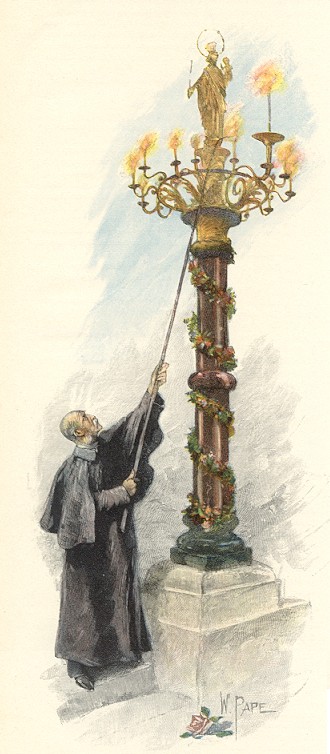
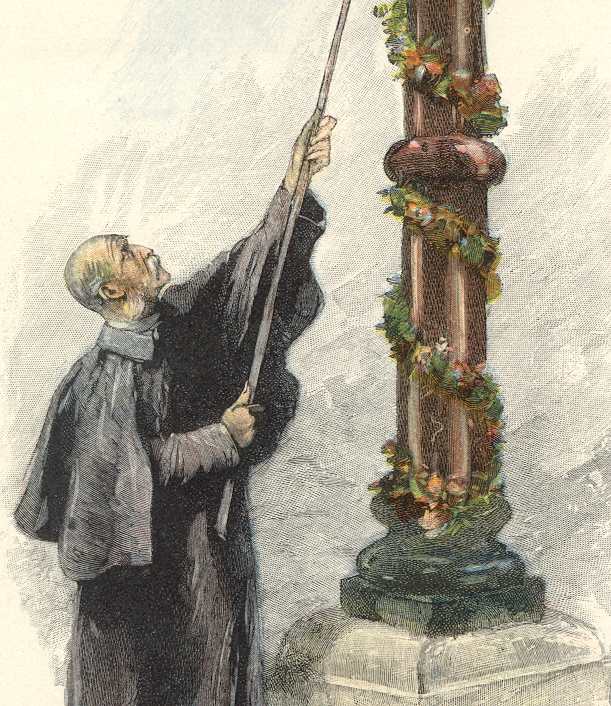
Good relevant links... (For Northern Tradition links see my homepage.)
A Christo-Hellenic Synthesis
The Almond Jar Graeco-Roman Demipaganism
Shrine of the Sleeping Gods
Antistoicus provides sound theology with a refreshing cultural cohesiveness.
A Non-Neo-Pagan
Christo-Pagan forum
R.J. Stewart.org
Magazine and Anthology
Articles by R.J. Stewart
Dreampower
The UnderWorld Tradition as taught by R.J. Stewart deeply ties into my own
understanding of Hela's realm. I am particularly informed by Power Within The
Land: The Roots of Celtic And Underworld Traditions Awakening The Sleepers And
Regenerating the Earth. For a good balance to this study from a purely
Teutonic perspective I would highly recommend the
Circle of Ostara's
two books on Odinic Mythology which are grounded in the essential
work of Viktor Rydberg.
The Grail Chapel of Our Lady Ordo Arcanorum Gradalis Shadwynn has, over the years, tremendously influenced my spiritual outlook with his incredible book The Crafted Cup. Shrine of the Holy Grail
Loxley Abbey Church and Mini Farm
The Church of Robin Hood
Santeria
The Eckhart Society The Meister Eckhart Site Meister Eckhart Dominican Spirituality In the Rhineland
The Ivy-Covered Cross an exploration of the connections between Christ and Dionysos
Esoteric Theological Seminary The Northern Way has a multifaceted Mystery School studying Occult Christianity and Heathen Ancestral traditions.
"In Anglo-Saxon, the word bead meant both a bead and a prayer. The
standard cord of the Northern Tradition has nine knots, each of which represents one of
the nine worlds. ...I have also seen a Northern Tradition rosary with 81 knots, which
multiplies the ninefold ninefold."
- Nigel Pennick, Practical Magic in the Northern Tradition
1989
The Holy Gnostic Rosary
The Goth Rosary Our Lady's Rosary of the
Seven Rays
The Rosary of Our Lady
options for the Rosarian with Gnostic leanings
Meditations on the Anglo
Saxon Rune Poem from the English Folk Church
Monsalvat articles about Wagner's Parsifal In the Northern Tradition there are many names for Christ. Parsifal is one of them.
(This link is currently dead.)Sedlec Ossuary Page
an interesting chapel located in the Czech town Kutna HoraThe Last Temptation of Christ the brilliant and inspirational novel by Nikos Kazantzakis
Of Wood & Water my own poetry and prose with the Christo-Heathen theme (on site)
The Division of Consciousness: The Secret Afterlife of the Human Psyche by Peter Novak
The Origins of Christianity and the
Quest for the Historical Jesus Christ
Jesus Christ, Man or
Myth??
Christ a
Fiction
The Essenes and their Way of Life writings by Olivier Manitara
The Norwegian Pentagram Gnosis (Knowledge) is power. Whether we use it appropriately or not is entirely up to us. If there is any truth to this new book by Harald Sommerfeldt Boehlke, Gnosticism may have been ab-used in the persecution of our people. It is possible that the 'Christening Kings' of Norway misused the Occult currents generated by Gnostic Christianity to commit their crimes of genocide. This manipulation of mystic energy could be why Odin, at one point, took an interest in the wretched "Saint" Olaf.
(This link is currently dead.) While only a cyber church at the moment, this is an absolutely incredible Christian development! I am proud to be an early member of this formative denomination.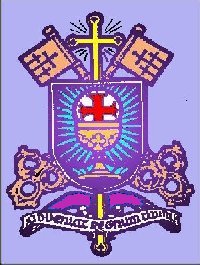 The Liberal Catholic Church, Province
of the USA
The Liberal Catholic Church, Province
of the USA
Here is an interesting prayer from Ecclesia
Gnostica The Hail Sophia
Hail Sophia, filled with light, the Christ is with Thee, blessed art Thou among the
Aeons, and blessed is the Liberator of Thy light, Jesus. Holy Sophia, Mother of
all gods*, pray to the light for us Thy children, now and in the hour of our
death. Amen.
*emphasis mine
In addition to the highly recommended English
Folk Church Society, Liberal
Catholic Church and Ecclesia
Gnostica, the following churches might also be compatible with native ways.
The Free Catholic Church The
Gnostic Orthodox Church Church of
Antioch
The Apostolic Johannite Church Essene Nazarean Church of Mount Carmel
Ecclesia Gnostica
Catholica Hermetica
The Gnostic Alchemical Church of
Typhon-Christ Ecclesia
Gnostica Universalis
The Contemporary Catholic Church
The Independent Church of Australia
The Avalonian Catholic Church
Unity School of Christianity a unique and worthwhile Protestant denomination
These may be of interest to the student of Christian occultism.
CANA- Christians Awakening to a New Awareness
The Christaquarians
Theosophical Society Blavatsky Net Foundation A Page About Freemasonry
AMORC
Rosicrucian Fellowship
A
Course in Miracles Foundation for A
Course in Miracles YezidiTruth.org
Gnostic Info
Urantia Foundation The Urantia Book Fellowship Oahspe A Faithist Path Sophia Foundation
Anthroposophical Society in America
Order of Nazorean Essenes: A Buddhist
Branch of Original Christianity The Masonic Moroni
Barry's Early
Christianity and Mormonism Page
The Talmud of Jmmanuel
La Santisima Muerte There is a
skeletal Mexican saint that strongly reminds me of the Teutonic Urd/Hela.
This mysterious saint has three aspects and was originally an Aztec goddess of
death. She is now seen as a variation of the Virgin Mary.
Dedications
A special dedication goes to Andrew Waterhouse of the English Folk Church Society. His valuable and slightly more orthodox form of Christo-Heathenry continues to inspire me.
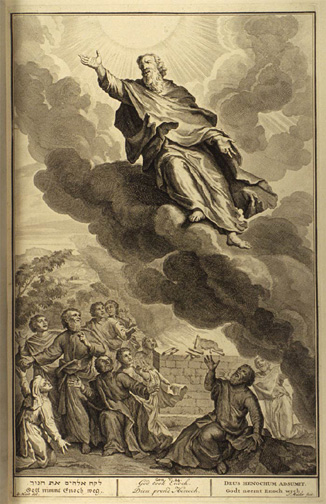
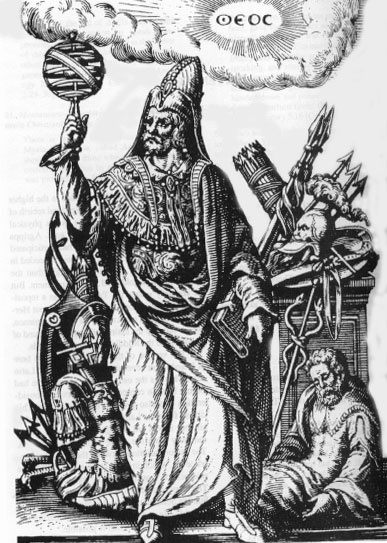
Enoch was often equated with Hermes Trismegistus and could well be considered
an avatar of Odin outside the Northern Tradition.
"Hermes Trismegistus
has a unique name meaning "Thrice Great Hermes." A true esoteric Christo-Pagan
saint, he even has his own feast day, May 24. The Greek word on the cloud in the
picture at right says God or Theos. During the Renaissance he was known as the
"Gentile Moses," because his wisdom writings rivalled the books of Moses but
were "pagan". His teachings are a blend of Egyptian, Gnostic and Greek paganism
combined with early primitive Kristianity."
-
http://www.northernway.org/saints.html#hermestri
"The name Hermes-Trismegistus became known through Latin authors even to
the scholars in the middle age convents, amid, as a matter of course, those who
believed that Odin was identical with Hermes also regarded him as identical with
Hermes-Trismegistus."
-Viktor Rydberg, Teutonic Mythology
asalibcat@hotmail.com
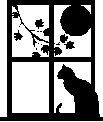
"Bury me by night,
"Time ends when there is no before and after, when you see
at a glance all that has ever happened and will ever happen. In this immediate
vision you will possess all things."
- Meister Eckhart, 14th century